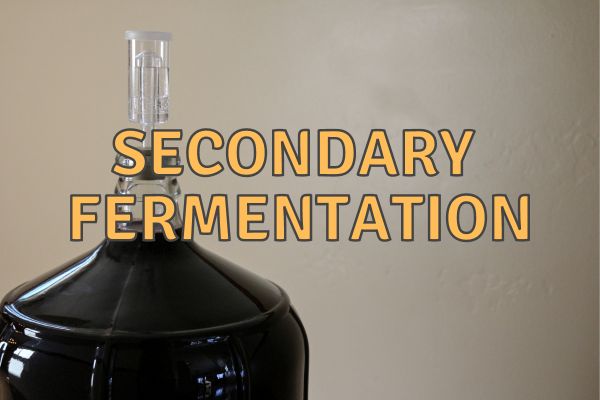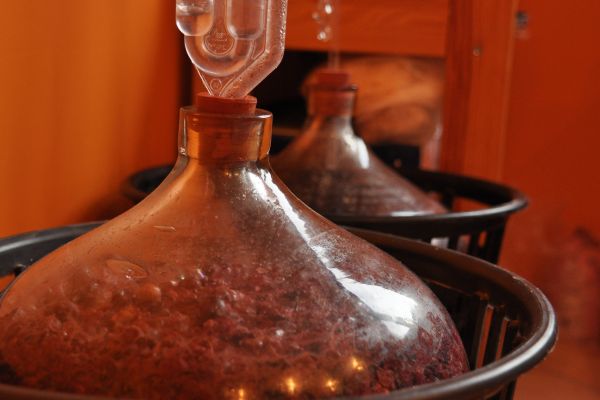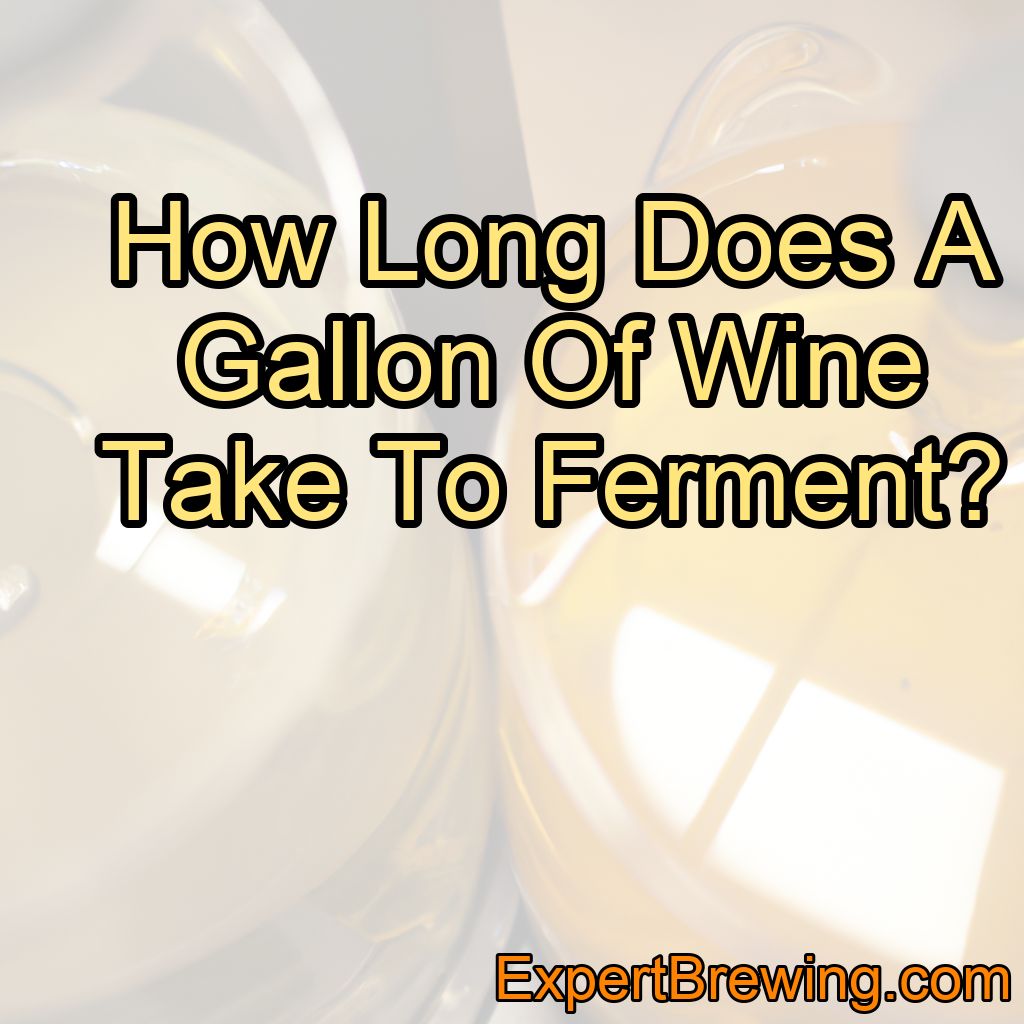How long does a gallon of wine take to ferment? The process of fermenting wine is a complex and delicate one, and the time it takes can vary depending on several factors.
In general, primary fermentation can take anywhere from 5 to 14 days, while secondary fermentation and aging can last several months or even years.
In this blog post, we will explore the various factors that influence the fermentation process, as well as offer tips and insights based on personal experience.
The Importance of Primary Fermentation
The primary fermentation stage is crucial to the development of a wine’s flavor and aroma. It is during this stage that the yeast consumes the sugar in the grape juice, producing alcohol and carbon dioxide.

The length of primary fermentation depends on factors such as the temperature, the yeast strain used, and the sugar content of the grape juice.
Temperature
Temperature plays a significant role in the speed of fermentation. Warmer temperatures can cause the yeast to work more quickly, while cooler temperatures can slow down the process.
Ideal fermentation temperatures can range from 60-75°F (15-24°C), and maintaining a consistent temperature is essential for a successful fermentation.
Yeast Strain
The type of yeast used can also affect the fermentation process. Different yeast strains have varying fermentation rates and alcohol tolerance levels. Some strains are known for their fast fermentation, while others may take longer to produce the desired results.
Sugar Content
The amount of sugar in the grape juice can also impact the length of primary fermentation. More sugar means the yeast has more to consume, which could result in a longer fermentation period.
The Significance of Secondary Fermentation
Once primary fermentation has been completed, it is time for the wine to undergo secondary fermentation.

This process allows the wine to develop more complex flavors and aromas, as well as clarify and stabilize.
The length of secondary fermentation can vary depending on the type of wine being produced and the winemaker’s preferences.
Types of Wine
Different types of wine may require different lengths of secondary fermentation. For example, red wines typically require a longer secondary fermentation period than white wines. This extended time allows the wine to develop a richer, more complex flavor profile.
Winemaker’s Preferences
The winemaker’s preferred style and taste can also affect the length of secondary fermentation. Some winemakers may choose to extend the fermentation process to achieve a specific style or flavor profile, while others may opt for a shorter period to retain more of the wine’s fruitiness and freshness.
The Aging Process
After fermentation is complete, the wine enters the aging process. The length of time a wine is aged can have a significant impact on its flavor and overall quality.

Wine can be aged in various vessels, such as stainless steel tanks, oak barrels, or glass bottles. The choice of aging vessel, as well as the duration of aging, can vary depending on the type of wine and the winemaker’s goals.
Stainless Steel Tanks
Stainless steel tanks are often used for aging white wines, as they allow the wine to maintain its freshness and fruitiness. The wine can be aged in these tanks for several months before bottling.
Oak Barrels
Aging wine in oak barrels can impart additional flavors and characteristics to the wine, such as notes of vanilla, spice, and toast. The length of time a wine is aged in oak can vary, with some wines spending just a few months in barrels, while others may age for several years.
Glass Bottles
Once the wine has been bottled, it can continue to age and develop in the bottle. Some wines, such as vintage ports and certain red wines, can benefit from years or even decades of bottle aging.
Factors Affecting Fermentation Time
In addition to the factors already discussed, there are several other variables that can impact the length of the fermentation process. These include the nutrient content of the grape juice, the health of the yeast, and the presence of other microorganisms.
Nutrient Content
For a successful fermentation, the yeast requires certain nutrients, such as nitrogen and vitamins. If the grape juice is lacking in these nutrients, the fermentation process can be slowed or even stalled.
Yeast Health
The health of the yeast can also impact the fermentation process. Healthy yeast will work more efficiently, while stressed or unhealthy yeast may struggle to ferment the wine properly.
Microorganisms
The presence of other microorganisms, such as bacteria, can compete with the yeast for nutrients and potentially slow down or spoil the fermentation process.
How do you know when homemade wine is done fermenting?
When homemade wine is done fermenting, there are a few signs to look for. Firstly, the fermentation process usually takes around 1-2 weeks, but this can vary depending on the recipe and conditions.
One indicator is the cessation of vigorous bubbling in the airlock or the disappearance of visible fermentation activity.

Additionally, you can measure the specific gravity of the wine using a hydrometer. When the specific gravity remains constant over a few consecutive days, it suggests that fermentation is complete.
Lastly, taste testing the wine can help determine if it has reached the desired level of dryness or sweetness. It is important to ensure that the wine has cleared and no longer produces sediment before considering it fully fermented.
Troubleshooting a Stuck Fermentation
Sometimes, despite our best efforts, the fermentation process can become stuck or stalled. This can be due to a variety of factors, such as insufficient nutrients, temperature fluctuations, or the presence of other microorganisms. If you suspect your fermentation is stuck, there are a few steps you can take to try and get it back on track:
1. Check the temperature: Ensure the wine is being fermented at the ideal temperature for the yeast strain being used.
2. Add nutrients: If the yeast is struggling due to a lack of nutrients, consider adding a yeast nutrient to the must.
3. Aerate the wine: Gently stirring the wine can help introduce oxygen and revive struggling yeast.
4. Re-pitch the yeast: If all else fails, consider adding a fresh batch of yeast to the wine to kickstart the fermentation process.
Why did my wine not ferment to begin with?
There could be several reasons why your wine is not fermenting after a few days or at least 48 hours.
Firstly, it is possible that the yeast you used is not viable or active enough to initiate fermentation. It is recommended to use a fresh and reliable yeast strain for successful fermentation. Additionally, if the temperature is too low, yeast activity may be sluggish or completely halted.
Yeast requires a suitable temperature range (typically between 18-25°C or 64-77°F) to ferment effectively. Moreover, insufficient oxygen supply during the initial stages of fermentation can also impede yeast activity.
Ensure that your wine has been adequately aerated before adding the yeast. Lastly, high sugar content in the must can potentially inhibit yeast fermentation. If the sugar concentration is too high, yeast may struggle to ferment completely. In such cases, diluting the must or using specialized yeast strains for high sugar fermentation might be necessary.
Conclusion
The process of fermenting wine is a delicate and complex one, with the length of time it takes being influenced by numerous factors. To summarize, here are 10 key facts about the fermentation process and factors affecting its duration:
1. Primary fermentation can take anywhere from 5 to 14 days.
2. Secondary fermentation and aging can last several months or even years.
3. Temperature plays a significant role in the speed of fermentation.
4. Different yeast strains have varying fermentation rates and alcohol tolerance levels.
5. The amount of sugar in the grape juice can impact the length of primary fermentation.
6. Red wines typically require a longer secondary fermentation period than white wines.
7. The choice of aging vessel can impact the wine’s flavor and characteristics.
8. Nutrient content, yeast health, and the presence of other microorganisms can all affect the fermentation process.
9. Monitoring and maintaining consistent conditions throughout fermentation is crucial for success.
10. Troubleshooting a stuck fermentation may require adjustments to temperature, nutrient levels, or even re-pitching the yeast.
By understanding the factors that influence the fermentation process, you can better control the outcome and produce a wine that reflects your unique tastes and preferences. Happy fermenting!
FAQs
How long does it take for a gallon of wine to ferment?
The fermentation process for a gallon of wine typically takes around 1 to 2 weeks. However, it’s important to note that the exact duration can vary depending on various factors such as the type of wine, yeast used, temperature, and desired flavor profile.
How do I know when my wine is done fermenting?
You can determine if your wine is done fermenting by checking the specific gravity of the liquid using a hydrometer. When the specific gravity remains stable over several consecutive days, it indicates that fermentation is complete. Additionally, you can observe if there are no more bubbles or signs of active fermentation in the airlock. Tasting the wine can also give you an idea if it has reached the desired flavor profile.
Can wine ferment in 2 days?
No, wine typically takes several weeks to months to ferment. The fermentation process involves the conversion of sugar into alcohol by yeast, and this process requires time for the yeast to consume the sugar and produce the desired alcohol content.
How long should homemade wine ferment?
The duration of fermentation for homemade wine can vary depending on various factors such as the type of wine, the yeast strain used, and the desired flavor profile. In general, fermentation typically lasts anywhere from one to three weeks. However, it is important to monitor the specific gravity of the wine using a hydrometer to determine when fermentation is complete. When the specific gravity remains stable over several days, it indicates that fermentation has finished.




